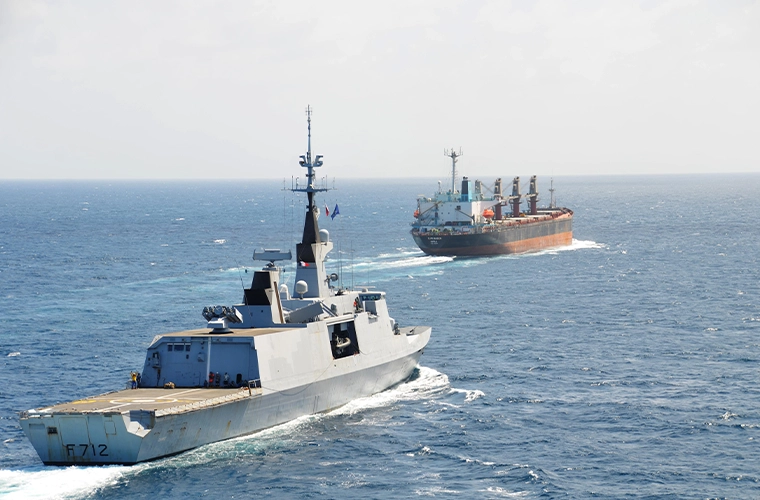French naval forces intercepted and detained two crew members aboard the oil tanker Boracay—a vessel long suspected of being part of Russia’s so-called “shadow fleet” and now under fresh scrutiny for possible links to the recent wave of mystery drone incursions into NATO airspace.
The arrests of the two crew members from the Boracay, a vessel long suspected of being part of Russia’s shadow fleet, represent a significant development. This is one of the strongest indications yet that Russia may be orchestrating the drone incursions recently reported in NATO airspace, underscoring the far-reaching logistical networks behind these aerial disruptions.
The arrests come on the heels of a sweeping wave of mystery drone incursions targeting sensitive sites across NATO countries over the past week. These incursions, which involve unidentified drones flying over military installations and critical infrastructure, have caused significant disruptions. Denmark has borne the brunt, with flights forcing the temporary closure of major hubs including Copenhagen, Oslo, Aalborg, and Billund airports. Since September 22, Sweden, Finland, Lithuania, France, and Germany have also reported drones operating near military installations and critical infrastructure.
Taken together, the incidents suggest a coordinated effort to probe Europe’s defenses, intensifying questions about who is directing the flights and how they are being launched.
According to reports, the French military first boarded the Boracay on September 27, ordering the tanker to anchor off Saint-Nazaire. French prosecutor Stéphane Kellenberger told Agence France-Presse (AFP) that two crew members—who identified themselves as the ship’s captain and first mate—were taken into custody for “failure to justify the nationality of the vessel” and “refusal to cooperate.”
Citing military and intelligence sources, several Danish media outlets reported that the French raid was ultimately prompted by suspicions that the Boracay had been used as a launch platform for the recent mystery drone incursions in NATO airspace.
Shipping records indicate that the Boracay departed from Primorsk, Russia, on September 20, officially bound for India. Its route took it through the North Sea and past Danish and German waters, as the mystery drone incursions were first being reported, from September 22 to 25.
During that same period, maritime trackers also logged two other Russian commercial vessels—the Oslo Carrier 3 and Astrol-1—alongside the Russian Ropucha-class landing ship Aleksandr Shabalin operating in waters off Denmark.
French President Emmanuel Macron, speaking at a summit of European Union leaders in Copenhagen, Denmark, declined to definitively confirm a link between Boracay and the drone events in NATO airspace, calling the French seizure of the vessel an “intervention.”
“I think it’s a good thing that this work has been done and that we’ve been able to stop it,” Macron told reporters. “There were some very serious wrongdoings made by this crew, which is why there are legal proceedings in the case.”
Asked about the seizure of the Boracay and arrests of its crew, Danish Prime Minister Mette Frederiksen declined to comment on the ongoing investigation but underscored the broader threat posed by Russia’s so-called “shadow fleet.”
“I can say in more general terms that we are facing a lot of problems with the shadow fleet. And that has been the case, especially in the Baltic Sea for quite a long time,” Frederiksen told reporters. “And we are working very closely together to battle this situation.”
According to Western security officials, Russia’s so-called “shadow fleet” refers to a vast network of hundreds of aging oil tankers and cargo ships that operate under obscure ownership structures, constantly shifting names and flags to evade sanctions and Western monitoring.
Officially, they are intended to transport Russian crude and other goods worldwide. However, Western intelligence services have long accused some of these vessels of being repurposed for covert activities, including the smuggling of sanctioned oil, to serve as staging points for electronic surveillance and, potentially, drone launches.
The fleet has been linked to several high-profile incidents in recent years, including suspected sabotage near undersea cables in the Baltic Sea and unexplained drone overflights of industrial infrastructure along the North Sea coast.
Following a series of mysterious drone sightings in August 2024 over nuclear power stations, liquefied natural gas terminals, and chemical plants near Brunsbüttel, Germany, defense officials provided some of the most detailed accounts yet of how Russia’s shadow fleet is believed to be waging what has been termed “hybrid warfare.”
Speaking on background, German law enforcement sources said Moscow had been deploying Orlan-10 drones from suspected shadow-fleet vessels stationed in the North Sea, just dozens of miles off Germany’s coast.
The Orlan-10 is a low-cost, fixed-wing UAV that Russia has relied on extensively for reconnaissance and intelligence gathering, making it a strong candidate for the mystery drones spotted over Europe.
According to the U.S. military’s Operational Environment Data Integration Network (ODIN), the aircraft can travel more than 370 miles at speeds just under 100 mph and typically operates between 3,000 and 5,000 feet—well within the altitudes NATO officials have reported. It can also fly autonomously along pre-programmed waypoints for up to 16 hours, a profile that mirrors the prolonged flight times documented in recent incursions.
Reports have also indicated that the vessel Boracay had been previously operated under the name Kiwala, a flagless tanker pretending to be registered in Djibouti. The Kiwala, previously sanctioned by the EU and the UK, was seized by the Estonian Navy in early April 2025 and later released that month.
This is not the first time ships from Russia’s so-called shadow fleet have been detained on suspicion of covert drone operations. In May, two Russian-crewed cargo vessels—the HAV Dolphin and the Lauga—were stopped after drones were spotted near German and Dutch military sites. Then, in early September, German special police reportedly seized another Russian freighter, the Scanlark, on suspicion of launching spy drones over a German Navy vessel. However, in each case, authorities failed to uncover conclusive evidence directly linking the ships to the mysterious drone activity.
For its part, Russia has repeatedly denied any involvement in the waves of mystery drone incidents that have plagued NATO for years. It has so far offered no direct response to the seizure of the Boracay.
On Thursday morning, the public prosecutor in Brest announced that the detention of the Boracay’s crew had been extended, but declined to comment on suspicions that the vessel served as a launch platform for drone incursions into NATO airspace.
Local media, citing military sources, also reported that French forces remain on board the tanker. However, no explanation has been given for their continued presence.
As of Thursday morning, VesselFinder showed the Boracay remains anchored roughly 18 nautical miles off Saint-Nazaire on the French coast.
Tim McMillan is a retired law enforcement executive, investigative reporter and co-founder of The Debrief. His writing typically focuses on defense, national security, the Intelligence Community and topics related to psychology. You can follow Tim on Twitter: @LtTimMcMillan. Tim can be reached by email: tim@thedebrief.org or through encrypted email: LtTimMcMillan@protonmail.com


